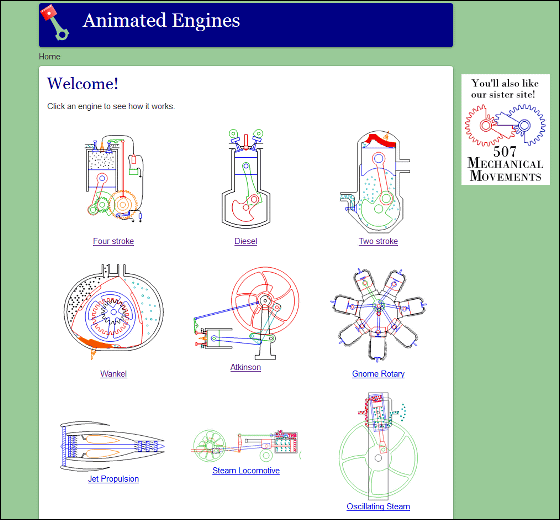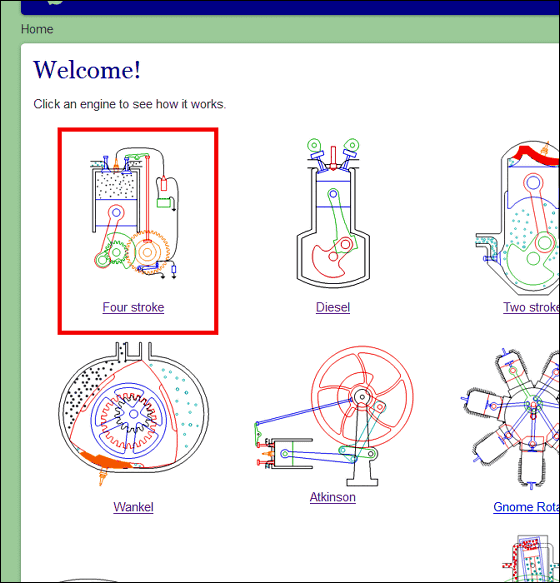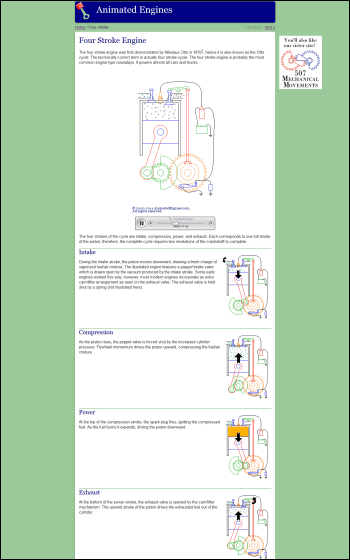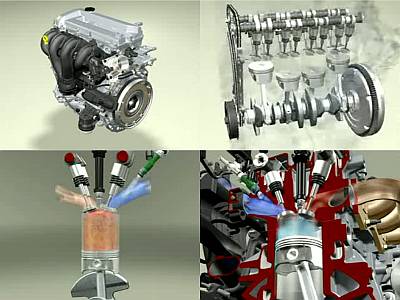"Animated Engines" which can see GIF animation of 21 kinds of engines including rotary, 4 stroke, steam engine etc

Engines such as automobiles and airplanes, vehicles and machines around the world are equipped with engines that generate power. Ever since the first steam engine was invented in the mid 1600's, people devised wisdom to develop better power mechanisms by devising various ideas. It is the animation that reproduces the wisdom of such predecessors "Animated Engines"is. There are 21 kinds of interesting animations released from what you see to what you see moving forward obliquely above forecast.
Animated Engines - Home
http://www.animatedengines.com/index.html

Click on the icon to proceed to the page where you can check the operation of each engine by moving animation. First, click "Four stroke (4 strokes)" which is a commonly used form.

The page was displayed. An animation is displayed at the top of the page, and below it the description of the motion is drawn one by one. In addition, at the time of article writing animation display on iPhone was not supported.

Each step of "inhalation", "compression", "combustion" and "exhaust" of air is explained in detail.

What was interesting here was the intake valve described in the upper left of the figure. It should normally have a mechanism for opening and closing the valve, but it is not shown in this figure. When reading the explanation, this valve seems to be structured to automatically open and close by the difference of the pressure when the piston goes down and the inside of the cylinder becomes negative pressure.

Clicking "Diesel (diesel) ... ....

Likewise, a detail page with animation opens

Recently the exhaust gas regulation and so on completely disappeared "Two stroke (2 stroke)" engine

In the figure, "inspiration on the crankcase side" is drawn first. A two-stroke engine without a valve performs intake and exhaust using the difference in atmospheric pressure created by the piston moving up and down.

This is also a minority rotary engine. In the English name it is called "Wankel engine (Wankel engine)". In June 2012, production of Mazda RX - 8 has ended, and rotary engines for commercial vehicles are not being produced.

Rotary type rotor rotates internally, creating power.

"Steam Locomotive" is, as its name implies, a mechanism used for steam locomotives.

It is a mechanism to convert high pressure steam generated by boiling water into driving force.

The mechanism older than the steam engine is "Newcomen Atmospheric (Newcomen Agency)". It is similar to the steam engine, but it is named "Atmospheric" because there is a process using atmospheric pressure.

First, when the piston is lifted by the force of the weight, steam from the boiler flows into the cylinder. Next, when water is injected into the cylinder, the cooled steam suddenly decreases its volume and loses pressure. When the pressure of the shrunk steam becomes lower than the atmospheric pressure, the piston is pushed downward in this time. It is a mechanism to generate power by repeating this up and down movement.

Variable engines are also being introduced. This is an engine that uses the pressure of carbon dioxide called "CO2 engine".

Instead of fuel and steam, the piston revolves with the pressure of CO2 supplied from the cylinder. It is used for miniature engines for models.

Here is how the model engine is moving. CO2 is injected from the gas cylinder and the propeller is rotated using that pressure.
Junior 451 CO2 Motor Running - YouTube
And at first glance it seems difficult to understand "Two Cylinder Stirling Engine" (2 cylinder Stirling engine).Stirling engineIs not a change in volume due to combustion, but a mechanism that uses the change in volume due to temperature change as a power source.

In the illustration, heat is applied to the lower cylinder from the bottom, the heated inside air expands to expand the piston and rotate the crankshaft. At this time, a part of the air is also carried to the upper cylinder connected by a pipe or the like.

Since the radiator fin is attached to the upper cylinder, the air is cooled and loses pressure. This in turn causes the force to return the piston, which is a mechanism to produce continuous rotational motion. The point is that a phase difference of 90 degrees is attached to the two pistons.

Besides this,Jet engineAnd the unusual change that the engine body rotatesNome · rotary engineYou can see the behavior of such as. Ali may be slow to look at the state of the engine showing mechanical movement beyond imagination.
Related Posts:







